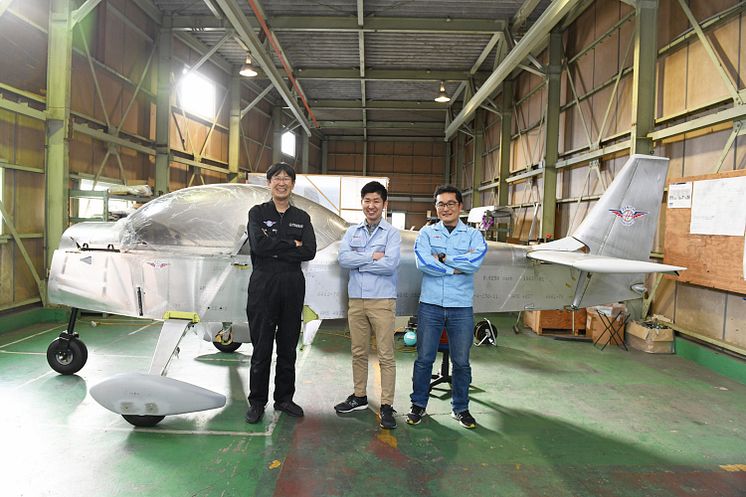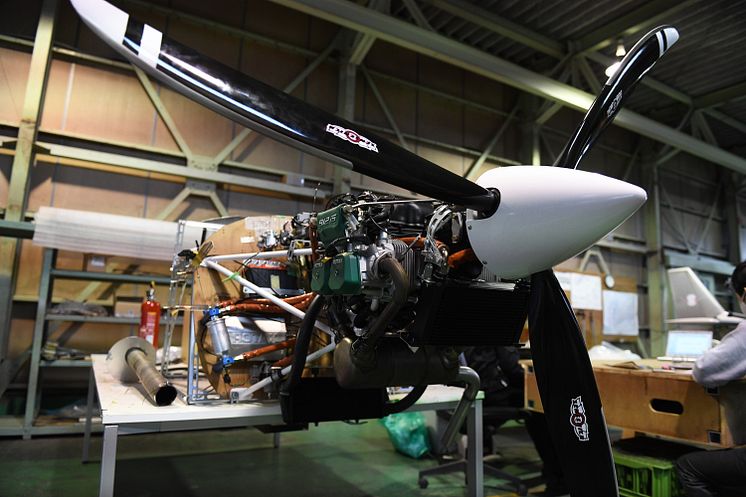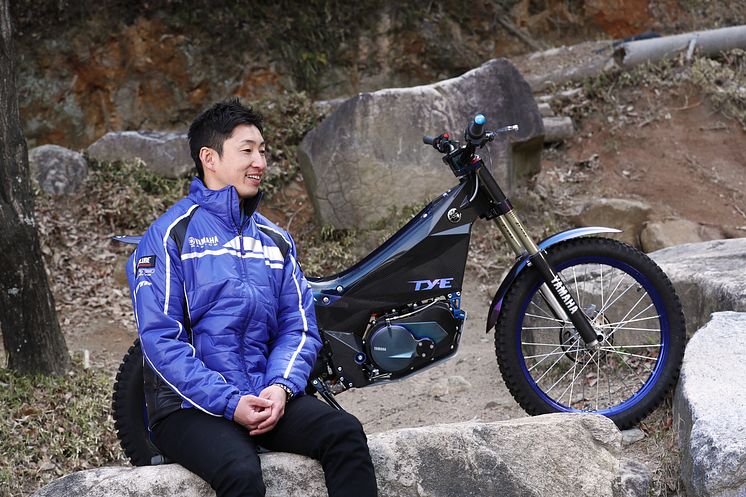
News -
Evolving R&D: Encouraging Independent Engineering Projects Yamaha Motor Newsletter (Apr. 8, 2021 No. 86)
Within Yamaha Motor’s R&D departments exists an in-house initiative called “Evolving R&D,” commonly referred to internally as the “5% Rule.” Aimed at encouraging our engineers to think more independently toward our Monozukuri, this initiative allows engineers to spend 5% of their working hours on their own research projects.
By applying themselves to their own R&D endeavors outside of their usual research assignments, the engineers get the chance to broaden their fields of expertise and devote their energies toward innovation that can lead to new kinds of uniquely Yamaha Kando.
The 5% Rule: Encouraging Creative Initiative

With its test-runs complete, the engine waits to be mounted on the prototype aircraft
“By taking things one step at a time, we’ve managed to get this far, and that’s something I feel really proud of,” says Tomoki Kaneshiro. A member of the Field and Service Robotics Development Division of Yamaha Motor’s Research & Development Section, Kaneshiro has been renting a warehouse near his workplace to serve as a “secret hideout,” and for the past four years he has been gradually assembling a small aircraft.
For engineers in Yamaha’s R&D departments, the Evolving R&D program—commonly referred to as the “5% Rule”—gives them the freedom to spend 5% of their working hours on their own independent research projects unrelated to their day-to-day work. The aim is to allow them to broaden their fields of expertise as engineers and put their energies toward new innovations. Yamaha Motor is a company involved in a broad range of businesses with equally diverse product lines, from motorcycles, outboard motors, boats and recreational off-highway vehicles (ROVs) to electrically power-assisted bicycles, personal watercraft, electric wheelchairs and golf cars. This wide-ranging portfolio of businesses is the result of a long tradition and culture in our R&D divisions for bringing free-thinking and creative ideas to our
Monozukuri (creating products with an emphasis on craftsmanship and excellence).
“Evolving R&D activities provide the means and an open door for engineers to direct their personal passion toward a goal. For us, that goal is to develop an aircraft with the same characteristics as a motorcycle, something sporty and close to personal mobility,” explains Kaneshiro. “As the first step toward realizing that goal, we’re assembling a kit airplane to learn the basics of aircraft design and construction firsthand.”
An Aircraft More Like a Motorcycle

Determined to make whatever they can themselves, the team is trying to build parts on their own like this pilot’s seat
Last year, after assembling the aircraft’s main fuselage, the team mounted a powerplant in a handmade test frame and began testing the engine. This year, they have installed the engine on the aircraft itself and started fabricating the plane’s main wings. “Finishing that is our plan for 2021. After that, we plan to conduct performance checks and tests as well as prepare all the documentation toward obtaining approval to conduct real flight tests,” says Kaneshiro.
By building an aircraft capable of flight with their own hands in this project, the team will not only acquire the knowledge for creating aircraft design blueprints, but also gain relevant analytical know-how and maintenance skills. And each time they encounter a barrier to progression, they scratch their heads and work to find solutions, and the longer this takes, the more they feel for certain that they are gradually moving closer and closer in this challenge to successfully develop a “motorcycle-like aircraft.”
“When going touring with a motorcycle, you can go alone or with friends and still enjoy it, right?” continues Kaneshiro. “There’s also the thrills you can get from competing in races, the fun in customizing your bike to be exactly how you want it to be, or just talking about bikes with your friends in the garage or workshop. These are all part of what makes motorcycling so appealing, so what we’re aiming for is an aircraft that can provide the same kinds of enjoyment.”
One of the design sketches showed a fuselage with the pilot straddling the seat like a motorcycle and another seat behind it with a passenger on it. “It may look like some kind of crazy fantasy for some, but you can’t create something new without first showing what it is you hope to achieve, and this is the kind of vehicle we want to create,” he concludes.
An Evolving R&D Project That Took on the World’s Best

The TY-E electric trials bike and its chief developer, Takeshi Toyota
In this issue, we also want to introduce another product of Yamaha’s Evolving R&D initiative—the TY-E electric trials bike. The project leader, Takeshi Toyota, is a Yamaha engineer who personally enjoys competing in amateur trials as a hobby. “The biggest issue with electric motorcycles is their range, but range isn’t a factor in trials riding. By taking that out of the equation, we can put resources toward the areas needed in trials, like low-end torque delivery and quick motor response when you get going. I’ve long felt that EVs might be a great fit for trials,” explains Toyota. It was the company’s Evolving R&D program that helped him turn that conviction into a real vehicle.
With support from the company, Toyota was able to enter the TY-E he and fellow volunteers developed to compete in the 2018 FIM Trial-E Cup specifically for electric motorcycles, ridden by 11-time All Japan Trial Champion Kenichi Kuroyama. In the first round of the series, Kuroyama and the TY-E scored a debut win and eventually finished the competition as the runner-up overall.
There are many more Evolving R&D projects underway besides the small aircraft and the trials bike introduced here. Among the more intriguing undertakings are engineers working under the 5% Rule to do research into bobsleds. We hope people everywhere will look forward to more unique products and uniquely Yamaha
Kando born of the free and open-minded culture of our R&D divisions.
* Kando is a Japanese word for the simultaneous feelings of deep satisfaction and intense excitement that we experience when we encounter something of exceptional value.
Moving You Short Documentary Series
Challenge, Ascend, Overcome. Youthful Passion to the World
|
Message from the Editor Tomoki Kaneshiro, the leader of this small but ambitious group building an aircraft from scratch toward a shared vision, was also very involved with building human-powered aircraft in his college days. After joining Yamaha Motor, he was part of the company’s human-powered aircraft club, Team Aeroscepsy, as it competed for the world record for human-powered flight. While he is currently stationed in an R&D division, he has previously worked on designing our industrial-use unmanned helicopters. There’s an abundance of energy and passion driving him, but also a steadiness in how he doesn’t rush things, moving everything forward with short but sure steps. His small-aircraft project has an air of engineering purity and is a tribute to the true spirit of Yamaha Monozukuri. Maiko Kawai |




